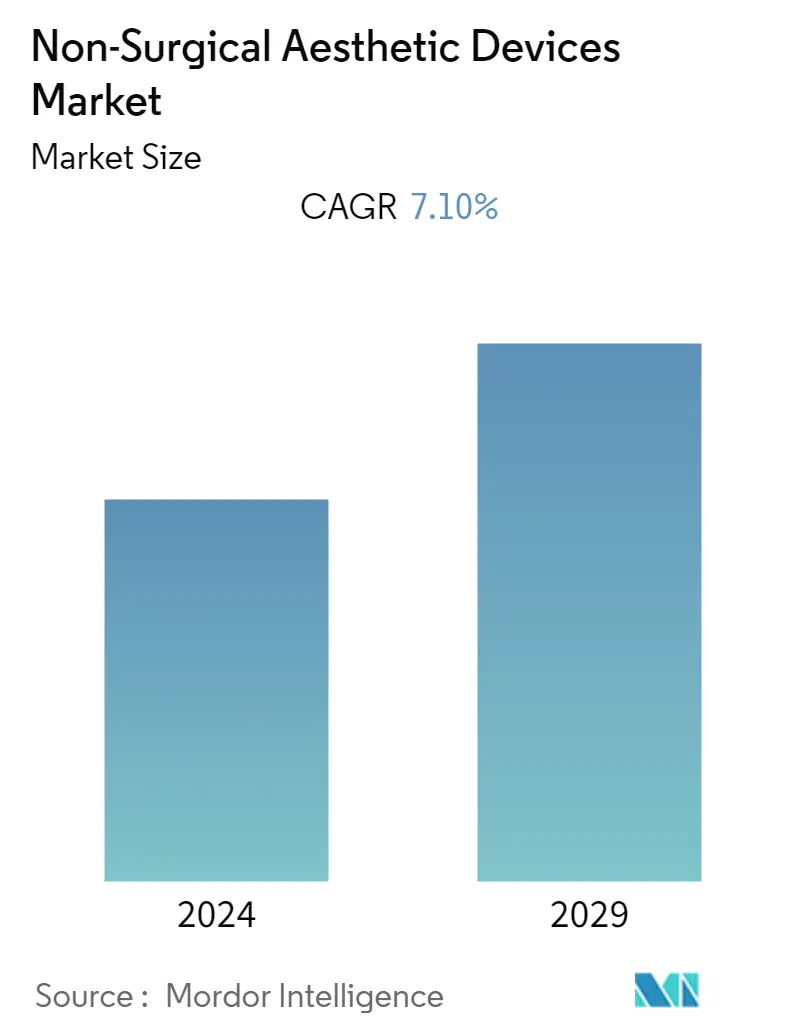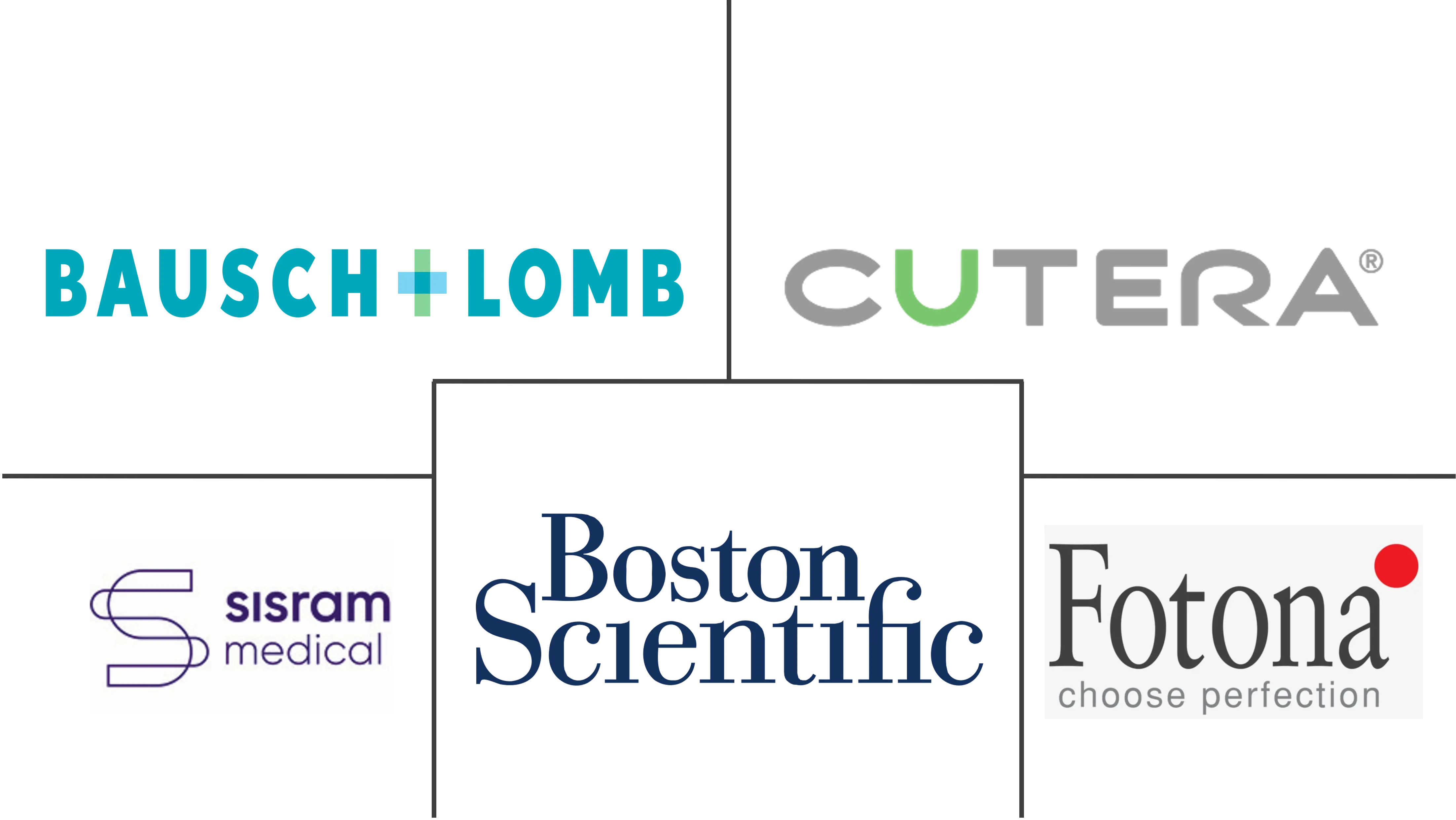Market Size of Non-Surgical Aesthetic Devices Industry

| Study Period | 2019 - 2029 |
| Base Year For Estimation | 2023 |
| CAGR | 7.10 % |
| Fastest Growing Market | Asia Pacific |
| Largest Market | North America |
| Market Concentration | Medium |
Major Players
*Disclaimer: Major Players sorted in no particular order |
Non-Surgical Aesthetic Devices Market Analysis
The non-surgical aesthetic devices market studied is expected to register a CAGR of nearly 7.1% during the forecast period.
- COVID-19 had a profound impact on the non-surgical aesthetic devices market owing to the cancellations of cosmetic procedures in the initial phase of the pandemic. For instance, an article published in the Journal of Plastic, Reconstructive, and Aesthetic Surgery (JPRAS) in September 2021 stated that all elective and aesthetic procedures were canceled or deferred by government-mandated quarantine measures.
- However, the market recovered in the later phase of the pandemic and reported a high number of non-surgical aesthetic procedures, despite restrictions. For instance, according to the Aesthetic Society, Aesthetic Plastic Surgery National Databank 2021 report, non-surgical aesthetic procedures increased by 44% in 2021 in the United States. Currently, the market is significantly growing owing to the high demand for non-surgical aesthetic procedures and advancements in devices worldwide. The market is expected to register stable growth during the forecast period.
- The increasing demand for non-surgical aesthetic procedures and technological advancements in non-surgical aesthetic devices are expected to be primary growth factors of the studied market. For instance, according to the Aesthetic Neural Network (ANN) 2021 data, Americans spent over USD 3 billion on non-surgical aesthetic procedures from January to June 2021. Also, according to the Aesthetic Plastic Surgery National Databank 2021 report, about 423.8 thousand non-surgical hair removal procedures were performed in women and 26.4 thousand in men. Hence, the large number of hair removal procedures is expected to propel the utility of non-surgical aesthetic devices such as lasers, thereby propelling the market growth during the forecast period.
- The strategic initiatives adopted by market players, such as product launches, approvals, and partnerships, are also contributing to the market growth during the forecast period. For instance, in February 2021, Osaka-Gunze Limited's subsidiary Medical U&A obtained government approval to produce and sell the long-term hair reduction diode laser MeDioStar Monolith in Japan. It is a 6th-generation diode laser developed by Asclepion Laser Technologies GmbH in Germany. Also, in June 2022, Cynosure launched the Elite iQ aesthetic workstation for laser hair removal and skin revitalization in the United States, Europe, and Australia. Such rising launches are expected to boost market growth during the forecast period.
- Therefore, with the increasing demand for painless skin tightening treatments, the rising demand for laser hair removal procedures, and increasing launches and approvals of technologically advanced non-surgical aesthetic devices, the studied market is anticipated to witness growth over the analysis period. However, the high cost of the devices and the need to repeat the procedures to maintain the appearance are the major restraints to the growth of the market.
Non-Surgical Aesthetic Devices Industry Segmentation
As per the scope of the report, non-surgical devices are used for skin tightening, which is a minimally invasive technique, where targeted energy is used for heating up deeper layers of skin to stimulate elastin and collagen production, which in turn gradually improves skin tone and texture.
The non-surgical aesthetic devices market is segmented by type (laser-based aesthetic devices, radiofrequency (rf) based aesthetic devices, ultrasound aesthetic devices, intense pulsed light devices, and other types), application (skin resurfacing and tightening, body contouring and cellulite reduction, hair removal, tattoo removal, and other applications) end-user(hospital, beauty clinics, and other end-users) and geography (North America, Europe, Asia-Pacific, Middle East and Africa, and South America). The report also covers the estimated market sizes and trends for 17 countries across major regions globally.
The report offers the value (in USD) for the above segments.
| By Type | |
| Laser-based Aesthetic Device | |
| Radiofrequency (RF) Based Aesthetic Device | |
| Ultrasound Aesthetic Device | |
| Intense Pulsed Light Device | |
| Other Types |
| By Application | |
| Skin Resurfacing and Tightening | |
| Body Contouring and Cellulite Reduction | |
| Hair Removal | |
| Tattoo Removal | |
| Other Applications |
| By End-User | |
| Hospital | |
| Beauty Clinics | |
| Other End-Users |
| Geography | ||||||||
| ||||||||
| ||||||||
| ||||||||
| ||||||||
|
Non-Surgical Aesthetic Devices Market Size Summary
The non-surgical aesthetic devices market is experiencing significant growth, driven by increasing demand for non-invasive cosmetic procedures and technological advancements in devices. The market, which faced challenges during the COVID-19 pandemic due to the cancellation of elective procedures, has rebounded strongly, with a notable rise in non-surgical procedures. This growth is fueled by the rising popularity of painless skin tightening treatments and laser hair removal, alongside strategic initiatives by market players such as product launches and partnerships. Despite the high cost of devices and the need for repeated procedures, the market is poised for stable expansion during the forecast period.
North America is expected to maintain a substantial share of the market, supported by a high number of cosmetic procedures, a concentration of market players, and frequent product launches in the region. The demand for non-surgical procedures is bolstered by increased awareness and interest in aesthetic treatments, as evidenced by rising searches for aging-related skincare solutions. The competitive landscape is characterized by major players developing advanced skin-tightening technologies and engaging in collaborations to strengthen their market position. Continuous innovation and product introductions are anticipated to further drive market growth, particularly in North America.
Non-Surgical Aesthetic Devices Market Size - Table of Contents
-
1. MARKET DYNAMICS
-
1.1 Market Overview
-
1.2 Market Drivers
-
1.2.1 Increasing Demand for Non-surgical Aesthetics Procedures
-
1.2.2 Technological Advancements in Non-surgical Aesthetic Devices
-
-
1.3 Market Restraints
-
1.3.1 High Cost of the Devices
-
-
1.4 Porter's Five Forces Analysis
-
1.4.1 Threat of New Entrants
-
1.4.2 Bargaining Power of Buyers/Consumers
-
1.4.3 Bargaining Power of Suppliers
-
1.4.4 Threat of Substitute Products
-
1.4.5 Intensity of Competitive Rivalry
-
-
-
2. MARKET SEGMENTATION (Market Size by Value - USD)
-
2.1 By Type
-
2.1.1 Laser-based Aesthetic Device
-
2.1.2 Radiofrequency (RF) Based Aesthetic Device
-
2.1.3 Ultrasound Aesthetic Device
-
2.1.4 Intense Pulsed Light Device
-
2.1.5 Other Types
-
-
2.2 By Application
-
2.2.1 Skin Resurfacing and Tightening
-
2.2.2 Body Contouring and Cellulite Reduction
-
2.2.3 Hair Removal
-
2.2.4 Tattoo Removal
-
2.2.5 Other Applications
-
-
2.3 By End-User
-
2.3.1 Hospital
-
2.3.2 Beauty Clinics
-
2.3.3 Other End-Users
-
-
2.4 Geography
-
2.4.1 North America
-
2.4.1.1 United States
-
2.4.1.2 Canada
-
2.4.1.3 Mexico
-
-
2.4.2 Europe
-
2.4.2.1 Germany
-
2.4.2.2 United Kingdom
-
2.4.2.3 France
-
2.4.2.4 Italy
-
2.4.2.5 Spain
-
2.4.2.6 Rest of Europe
-
-
2.4.3 Asia Pacific
-
2.4.3.1 China
-
2.4.3.2 Japan
-
2.4.3.3 India
-
2.4.3.4 Australia
-
2.4.3.5 South Korea
-
2.4.3.6 Rest of Asia-Pacific
-
-
2.4.4 Middle East and Africa
-
2.4.4.1 GCC
-
2.4.4.2 South Africa
-
2.4.4.3 Rest of Middle East and Africa
-
-
2.4.5 South America
-
2.4.5.1 Brazil
-
2.4.5.2 Argentina
-
2.4.5.3 Rest of South America
-
-
-
Non-Surgical Aesthetic Devices Market Size FAQs
What is the current Non-Surgical Aesthetic Devices Market size?
The Non-Surgical Aesthetic Devices Market is projected to register a CAGR of 7.10% during the forecast period (2024-2029)
Who are the key players in Non-Surgical Aesthetic Devices Market?
Fotona, Bausch & Lomb Incorporated, Cutera, Inc., Boston Scientific Corporation (Lumenis Inc.) and Sisram Medical (Alma Lasers) are the major companies operating in the Non-Surgical Aesthetic Devices Market.

